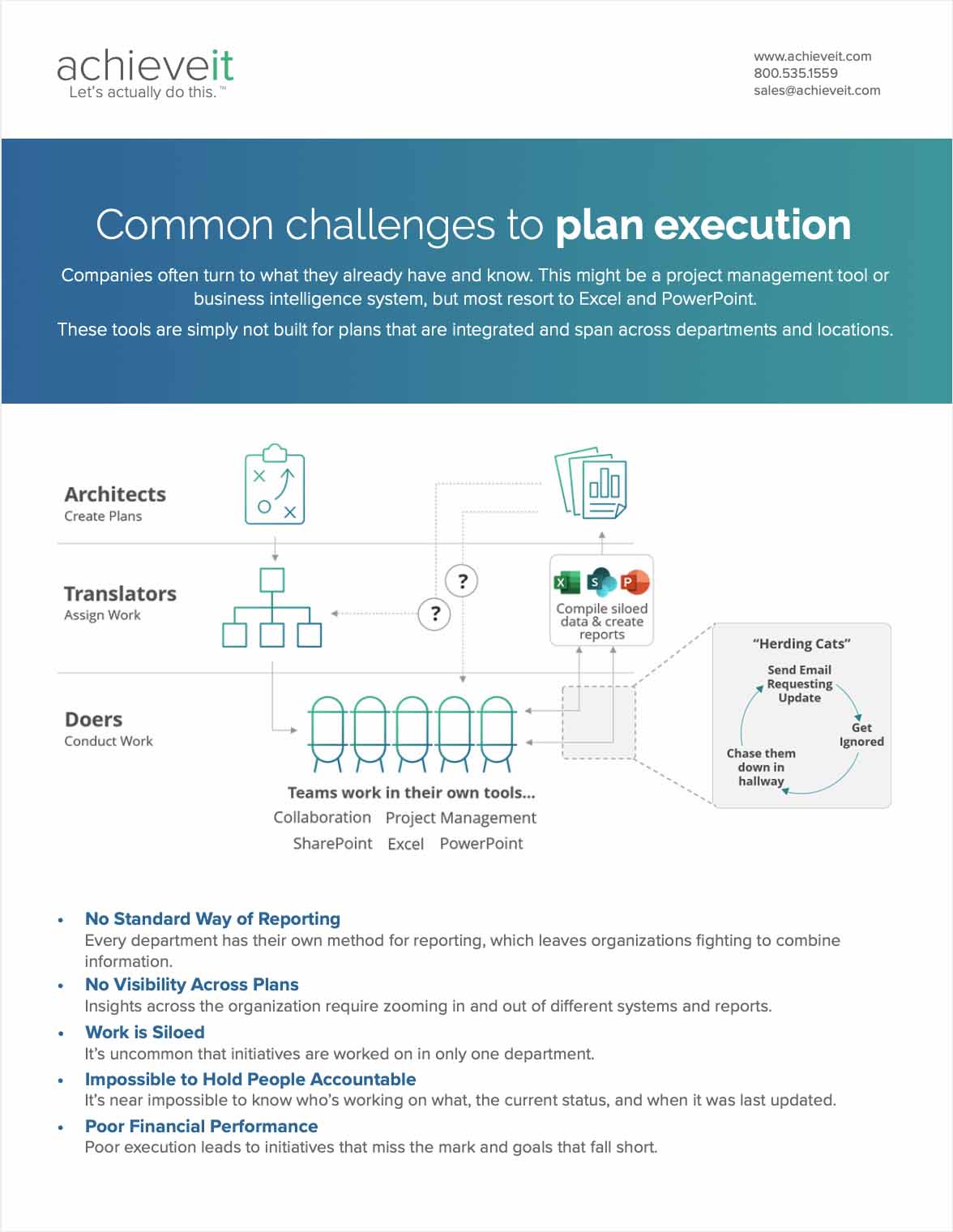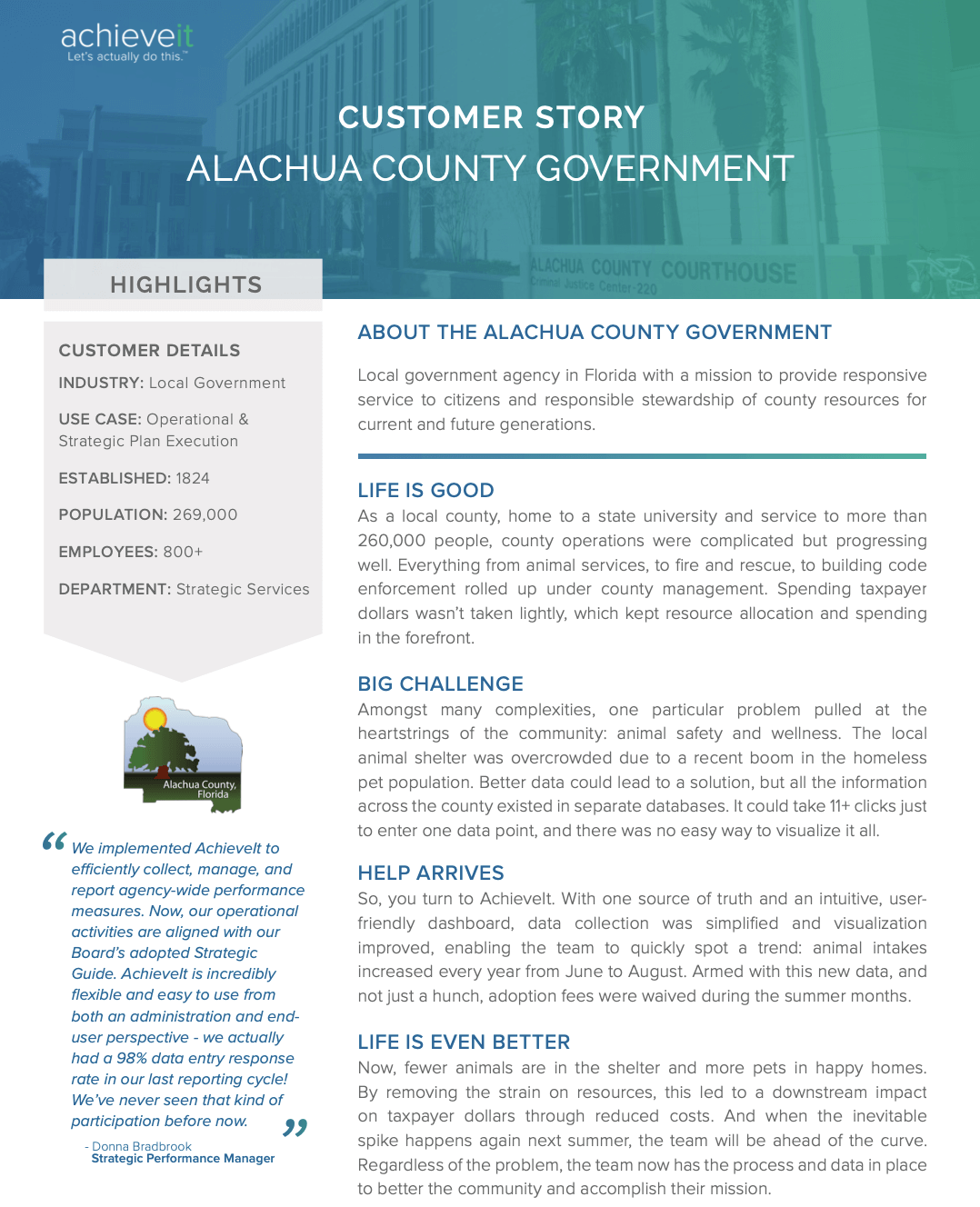With strategic planning and execution, organizations tend to get caught up in the processes, goals, and deliverables and forget about a crucial element — the human one. But your strategy is nothing without the people who turn it into a reality.
Organizations often struggle to involve the right people in their strategic planning and execution efforts. The result? Planning and execution that excludes key stakeholders, resulting in missed opportunities and a lack of buy-in.
Deciding who the “right people” are and how to involve them can be challenging.
But Jonathan Morgan, VP of Revenue Operations and Head of Marketing at AchieveIt, knows who the right people are: “They’re the ones that are actually getting the projects done, running the initiatives, and working within the different teams.”
Involving the right people looks different during the planning phase and the execution phase. In the strategic planning phase, you need input from stakeholders whose insights can guide you in the right direction. During the execution phase, you need to be dealing directly with the people who are responsible for each individual task.
The importance of identifying and engaging with the right people
Involving the right people in the strategic planning and execution processes means identifying and engaging the individuals who are best suited to provide valuable insights and perspectives on the organization’s goals, capabilities, and resources — at each phase.
This shouldn’t be just the top-level executives and managers in an organization. It should also involve front-line employees, customers, and other key stakeholders who can provide unique perspectives on the organization’s strengths, weaknesses, opportunities, and threats.
Having the right people ensures:
- Well-informed, designed, and executed strategies
- Alignment between organizational goals and capabilities
- More buy-in from stakeholders
The process of identifying and engaging with these individuals is an ongoing process of collaboration and constant communication.
FREE RESOURCE
Common Challenges to Plan Execution Guide
Download this guide to understand how organizations who establish uniformity, create visibility, and promote accountability excel at execution.

Error in the strategic planning phase: not gathering insight from affected stakeholders
In the planning phase, you’re asking the question, “Who are we today?” “Who do we want to be in the future?” and “How do we get there?” The most common mistake organizations make here is that they attempt to answer these questions without involving all relevant stakeholders.
The planning phase normally happens in a boardroom with the leadership team. Without the input of the people who will actually be doing the work, a lot of assumptions are made that might not reflect reality. Jonathan says that this process is a bit like Moses coming down the mountain with the 10 commandments in hand. “Moses tells the people, ‘These are our rules,’ but in strategy, that doesn’t work. It is out of touch with what customers are saying and the internal struggles within the organization.”
Solution: Identify key stakeholders and gather their input
This doesn’t mean that you need to involve every person in the organization from the start. That could get over complicated and counterproductive. You need to find a “balanced approach to gathering different opinions from the organization.” You can collect an overview of the feedback through things like small group sessions, town hall meetings, or stakeholder meetings from key individuals.
Jonathan says, “It’s beyond having an elite and exclusive group of leaders that are both deciding what we’re going to do and tracking how we’re going to do it. It’s expanding that out to a larger group in the organization.”
The first step is to identify who these key individuals are — those who can provide honest and productive input toward the plan. They could be the people who will be carrying out the work, are affected by it, or will influence it in some way. They could be people internal to the organization or external, such as community leaders or stakeholders. You can use techniques such as the RACI Matrix to identify your important stakeholders.
Error in the strategy execution phase: a lack of visibility and accountability
Very often, in the execution phase, company directors and executives tend to only communicate with senior leaders. If they need an update about a specific item, the senior leaders need to first obtain this information from a specific member or members of their team. But those people are missing key components of the day-to-day issues facing the team.
“It’s a constant game of telephone,” Jonathan says. “They’re not actually getting the full context of both the what and the why from the people that are actually doing the work.” This results in a disconnect — a lack of visibility and accountability.
Solution: Involve the people who are truly accountable for the work being done
When it comes to executing your strategy, you need to ensure that you’re speaking directly with people on the ground — those running the operation — not just the people leading them. It’s the only way to get a clear picture of what is happening.
As a strategy leader, collecting updates from the specific person responsible avoids a lot of back and forth between you, the team leaders, and the doers.
Open communication starts by assigning the responsibility of tasks to individuals and not teams or team leaders. When creating a new line item such as “conduct market research,” assign the responsibility to the individual who is actually going to carry out the work and not their team name or team leader. This person will be the same individual who will input updates and who leadership can go to if they require any clarification.
Leveraging a platform built for integrated plan management streamlines the process of collecting updates. The people responsible for each line item receive an automatic reminder once they are due to write an update. This ensures that updates happen regularly and in the same format across the organization.
Finally, assigning individual responsibility to a task not only creates more visibility and accountability. It also helps to foster a stronger sense of pride and ownership in the person doing all of the hard work. This sense of pride and ownership can have a positive effect on the strategy as individuals become more invested in the success of the project and are more motivated to achieve the goals and objectives.
FREE RESOURCE
Alachua County Customer Story
Read this customer story to better understand how a local county government agency reduced the number of homeless animals.

How Alachua County government reduced homeless dog populations by involving the right people
Overcrowding in Alachua County’s animal shelter led to a boom in the homeless dog population. Citizens and the local government wanted a solution, and the county knew that data could help solve the issue. There was just one problem: the data was spread across different entities.
The Alachua County government used AchieveIt to communicate with the right people to collect information in a way that is intuitive and user-friendly. They gathered data to identify adoption trends and noticed an increase in the summer months. Based on this, they waived adoption fees during those months to encourage even more adoptions. Now, their animal shelters aren’t crowded, and more dogs have found their forever homes.
Find out more about how Alachua County used AchieveIt to solve its animal overpopulation problem.



